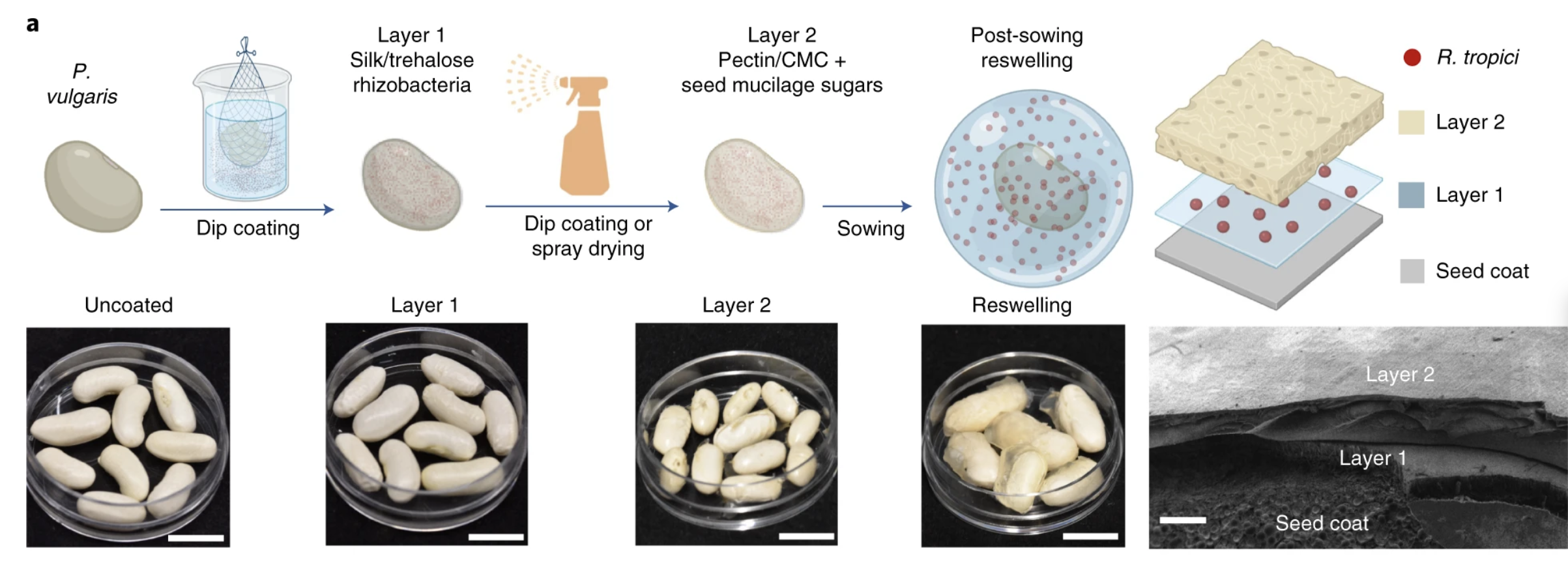- Water is the limiting factor for agriculture in many of the world’s semiarid regions, where crops are lost to drought in their early stages of life, during germination and as young seedlings.
- Scientists have developed a new seed coating, made from biodegradable waste products and applied directly to seeds before they are planted, to help seeds survive and germinate in dry conditions.
- The new seed coating consists of two layers: an inner one containing a nitrogen-fixing bacteria, and an outer one to hold moisture, much like a chia seed.
- Field trials with the new seeds are underway, but the key challenge to their adoption will be the cost.
What do you get when you combine silk cocoons, orange peel waste, beneficial bacteria, and a dash of innovation? Quite possibly a solution to growing crops in dry places, one group of researchers hopes.
Scientists from the Massachusetts Institute of Technology (MIT) and the King Mohammed VI Polytechnic University in Morocco have developed a new coating to help seeds survive and germinate in semiarid conditions. Their development has been published in the journal Nature Food.
The new seed coating consists of two layers of material applied directly to seeds before they are planted. The outer layer, made of orange peel waste processed into pectin, is designed to hold water and keep the seed from drying out during drought or water deficit. Inspired by the coats of chia and basil seeds, this layer creates a moist environment for the seed to survive until the conditions are right for germination.
The inner layer of the coating, applied directly to the seed, contains a type of bacteria held in place with material derived from silkworm cocoons. When exposed to water and soil, the rhizobacteria fixes nitrogen into the soil and provides some of the nutrients the seed needs to germinate, cutting down on the need for added fertilizers.
“This is the real added value to our seed coating,” Benedetto Marelli, professor of civil and environmental engineering at MIT and one of the scientists who worked on the new technology, said in a press release. “Because these are self-replicating microorganisms that can fix nitrogen for the plants, so they can decrease the amount of nitrogen-based fertilizers that are provided, and enrich the soil.”

Around 15% of the world’s land is in semiarid regions. There, water is the limiting factor for agriculture, affecting the food security of more than 1 billion people. In these drier lands, most crops are lost in their early stages of life, during germination and as young seedlings.
“Climate change started to affect our lives a while ago, but now we clearly see the impact day by day,” Marelli told Mongabay. “And so, we really need to find new solutions to make the agri-food system more resilient.”
Common beans (Phaseolus vulgaris) grown with the seed coat have performed well, and field trials are underway. If the test crops of beans improve harvests at a large scale, the next step is to try the coating on different crops and then to work with industry to make the technology affordable.
Ahmed Amri, honorary head of the genetic resources unit at the International Center for Agricultural Research in the Dry Areas (ICARDA), who was not involved in the study, told Mongabay that more investigation may be needed to show the benefits for the combined effects of drought both early and late in the plant’s life cycle — which is more common in arid zones — and not just during germination.
Applying the seed coat will add extra cost to the seeds themselves, but could save money on fertilizers and increase yields, offsetting the seed costs. All of the materials used in the coating are biodegradable and can be made from waste products, so the scientists hope this will also reduce production costs.

“For such innovations to actually help the farmers in the front line, they have to be locally adapted and appropriate,” Ola Westengen, an associate professor at the Norwegian University of Life Sciences, who was not involved in making the new technology, told Mongabay.
“It can be done locally. That’s one of the things we were thinking about while we were designing this,” said MIT doctoral student Augustine Zvinavashe, who developed the seed coating during his Ph.D. research. “The first layer you could dip coat, and then the second layer, you can spray it on. These are very simple processes that farmers could do on their own.” However, Zvinavashe said, it may cost less to coat the seeds in a central location that can store the rhizobacteria in sterile conditions.
Overall, Westengen said, seed innovations need to be accessible to farmers through less formal seed supply systems, such as seeds exchanged in social networks, bought at local markets, and saved from their own harvest. For example, in most drought-prone countries in sub-Saharan Africa, less than 20% of the seeds used for crops come from formal seed supply systems, in which farmers buy certified seeds of registered varieties.
“The greatest dream would be to make a technology that can have a real impact in the world,” Marelli said. “We want this material, this technology, to boost germination in marginal land to make crops more resilient to climate change.”
“Innovations that can make our crops more drought resistant are crucial,” Westengen said, “and will become even more so with the climate change that is already unavoidable.”
Citation:
Zvinavashe, A. T., Laurent, J., Mhada, M., Sun, H., Fouda, H. M. E., Kim, D., … Marelli, B. (2021). Programmable design of seed coating function induces water-stress tolerance in semi-arid regions. Nature Food, 2(7), 485-493. doi:10.1038/s43016-021-00315-8
Banner image of drought by World Meteorological Organization via Flickr class=”cc-license-identifier”>(CC BY-NC-ND 2.0)
Liz Kimbrough is a staff writer for Mongabay. Find her on Twitter: @lizkimbrough_
FEEDBACK: Use this form to send a message to the author of this post. If you want to post a public comment, you can do that at the bottom of the page.
